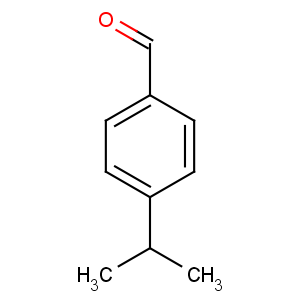Title: Cuminaldehyde
CAS Registry Number: 122-03-2
CAS Name: 4-(1-Methylethyl)benzaldehyde
Synonyms: p-isopropylbenzaldehyde; cuminal; cumaldehyde
Molecular Formula: C10H12O
Molecular Weight: 148.20
Percent Composition: C 81.04%, H 8.16%, O 10.80%
Literature References: Constituent of eucalyptus, myrrh, cassia, cumin, and other essential oils; prepared synthetically from
p-isopropylbenzoyl chloride. Alternate synthesis by formylation of isopropylbenzene under pressure: Crounse,
J. Am. Chem. Soc. 71, 1263 (1949). Toxicity study: P. M. Jenner
et al., Food Cosmet. Toxicol. 2, 327 (1964).
Properties: Colorless to yellowish, oily liq; strong persistent odor; acrid, burning taste. d20 0.978. bp760 235-236°; bp35 131-135°.
nD20 1.5301. Practically insol in water. Sol in alc, ether. LD50 orally in rats: 1390 mg/kg (Jenner).
Boiling point: bp760 235-236°; bp35 131-135°
Index of refraction: nD20 1.5301
Density: d20 0.978
Toxicity data: LD50 orally in rats: 1390 mg/kg (Jenner)
Derivative Type: Thiosemicarbazone
CAS Registry Number: 3811-20-9
Manufacturers' Codes: SHCH-58
Molecular Formula: C11H15N3S
Molecular Weight: 221.32
Percent Composition: C 59.70%, H 6.83%, N 18.99%, S 14.49%
Literature References: Prepn: P. P. T. Sah, T. C. Daniels,
Rec. Trav. Chim. 69, 1545 (1950); J. Bernstein
et al., J. Am. Chem. Soc. 73, 906 (1951).
Properties: Stout platelets from methanol, mp 147°. Practically insol in water. Moderately sol in alc.
Melting point: mp 147°
Use: In perfumery.

